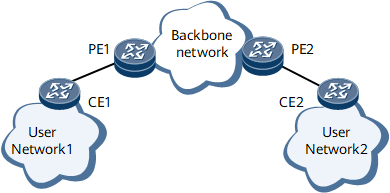Overview of Layer 2 Protocol Tunneling
Layer 2 protocol tunneling allows Layer 2 devices to use Layer 2 tunneling technology to transparently transmit Layer 2 protocol data units (PDUs) across a backbone network. Layer 2 protocol tunneling supports standard protocols, such as Spanning Tree Protocol (STP) and Link Aggregation Control Protocol (LACP), as well as user-defined protocols.
Layer 2 protocols running between user networks, such as Spanning Tree Protocol (STP) and Link Aggregation Control Protocol (LACP), must traverse a backbone network to perform Layer 2 protocol calculation.
On the network shown in Figure 1, User Network 1 and User Network 2 both run a Layer 2 protocol, Multiple Spanning Tree Protocol (MSTP). Layer 2 protocol data units (PDUs) on User Network 1 must traverse a backbone network to reach User Network 2 to build a spanning tree. Generally, the destination MAC addresses in Layer 2 PDUs of the same Layer 2 protocol are the same. For example, the MSTP PDUs are BPDUs with the destination MAC address 0180-C200-0000. Therefore, when a Layer 2 PDU reaches an edge device on a backbone network, the edge device cannot identify whether the PDU comes from a user network or the backbone network and sends the PDU to the CPU to calculate a spanning tree.
In Figure 1, CE1 on User Network 1 builds a spanning tree together with PE1 but not with CE2 on User Network 2. As a result, the Layer 2 PDUs on User Network 1 cannot traverse the backbone network to reach User Network 2.

To resolve the preceding problem, use Layer 2 protocol tunneling. The NetEngine 8000 F supports tunneling for the following Layer 2 protocols:
- Cisco Discovery Protocol (CDP)
- Ethernet Local Management Interface (E-LMI)
- Ethernet in the First Mile OAM (EOAM3AH)
- Device link detection protocol (DLDP)
- Dynamic Trunking Protocol (DTP)
- Ethernet in the First Mile (EFM)
- GARP Multicast Registration Protocol (GMRP)
- GARP VLAN Registration Protocol (GVRP)
- Huawei Group Management Protocol (HGMP)
- Link Aggregation Control Protocol (LACP)
- Link Layer Discovery Protocol (LLDP)
- Multiple MAC Registration Protocol (MMRP)
- Multiple VLAN Registration Protocol (MVRP)
- Port Aggregation Protocol (PAgP)
- Secure Socket Tunneling Protocol (SSTP)
- Spanning Tree Protocol (STP)
- Unidirectional Link Detection (UDLD)
- VLAN Trunking Protocol (VTP)
When Layer 2 PDUs enter a backbone network:
The ingress device replaces the multicast destination MAC address in the Layer 2 PDUs with a specified multicast MAC address so that it does not send the Layer 2 PDUs to its CPU for processing.

The specified multicast MAC address cannot be a multicast MAC address used by well-known protocols.
- The ingress device then determines whether to add an outer VLAN tag to the Layer 2 PDUs with a specified multicast MAC address based on the configured Layer 2 protocol tunneling type.
When Layer 2 PDUs leave the backbone network:
- The egress device restores the original multicast destination MAC address in the Layer 2 PDUs based on the configured mapping between the multicast destination MAC address and the specified multicast MAC address.
- The egress device then determines whether to remove the outer VLAN tag from the Layer 2 PDUs with the original multicast destination MAC address based on the configured Layer 2 protocol tunneling type.